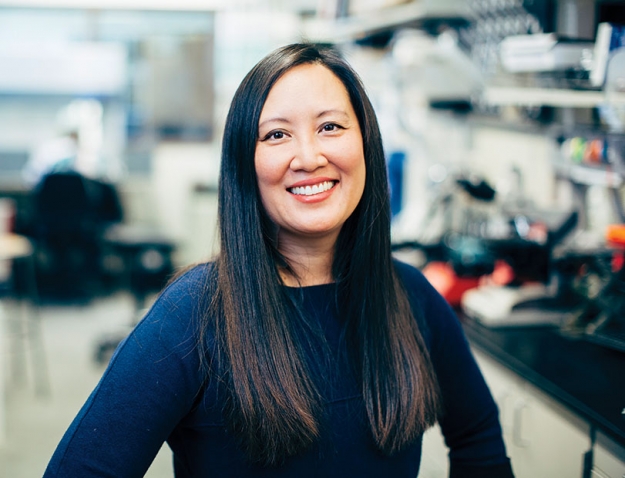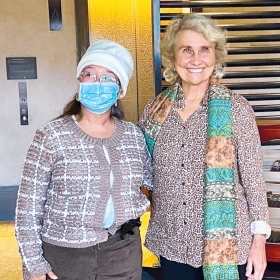Photo by Adrian Sanchez-Gonzalez
Connie Chang ’99 is perhaps the ultimate Swiss Army knife scientist—one with such a multifaceted approach to research (and so many scientific skills) that even she has trouble categorizing herself. In fact, she alternately describes herself as a bioengineer, a biophysicist, and a chemist. “It’s hard to say what field I am—I love every aspect of science,” Connie says, laughing. “Right now, science is highly multidisciplinary, and that’s what makes it exciting.”
Connie was a chemistry major at Wellesley, where she found a mentor in chemistry professor Shane Ohline. “She was instrumental in me attending graduate school, and it was also inspiring to see her balancing work and family,” Connie says. It was her research with Professor Ohline using a laser to explore cell membranes that sparked Connie’s interest in how chemistry and physics can be deployed to study biology.
Connie continued to develop a multitool research approach while working toward her Ph.D. in physical chemistry at the University of California, Los Angeles, and her postdoctoral work in physics at Harvard—and this approach is the centerpiece of her lab at Montana State University, where she studies population dynamics of bacteria and viruses.
“The overarching goal of my research is to understand heterogeneous populations at the single-cell level,” explains Connie, an assistant professor of chemical and biological engineering. “I’m interested in how single individuals within a population interact to make a collective whole.” One of Connie’s main interests is biofilms: diverse communities of bacteria that grow on surfaces ranging from the inside of an industrial pipe to medical implants.
To study biofilms, Connie uses a technique called drop-based microfluidics that involves encapsulating individual cells in tiny drops of water. The drops formed using a tiny plastic chip, where they can be rapidly analyzed as they zoom through channels the width of a human hair. Currently, Connie is using this technique to study bacterial resistance to antibiotics, screening bacteria exposed to different drugs to see which drugs work—a strategy that could someday be used to quickly test patients for antibiotic resistance.
She is also using drop-based microfluidics to study viruses—namely influenza. By placing individual cells infected with influenza in drops, she can examine how many and what types of viruses the cells produce—information that is crucial for creating accurate predictive models of viral evolution. “We don’t have a good handle on viral evolution yet because it’s so rapid, especially our native viruses like influenza,” Connie explains. “We can use drop-based microfluidics to keep up with the pace and scale.”
Connie’s experience with influenza means that her lab is well equipped to study the novel coronavirus, formally known as SARS-CoV-2. As this issue was in production, her lab was trying to create fast and simple point-of-care devices for health-care providers to measure both the virus itself and the antibodies that patients’ bodies may make after they recover from the infection. They were also grappling with fundamental questions like how a CoV might recombine with other viruses and how the human population size during transmission influences viral evolution. They were working with collaborators to build bat “organoids-on-a-chip,” which she describes as “mini-organs that you study in a lab.” Her team has extracted cells from bats that are susceptible to SARS-CoV-2 and was growing them into mini organs—namely gut and lung—so they can better study how these organs react to infection. “I’m excited about the new discoveries and exciting science to come that will help mitigate the current pandemic and prevent the next one,” she says.








We ask that those who engage in Wellesley magazine's online community act with honesty, integrity, and respect. (Remember the honor code, alums?) We reserve the right to remove comments by impersonators or comments that are not civil and relevant to the subject at hand. By posting here, you are permitting Wellesley magazine to edit and republish your comment in all media. Please remember that all posts are public.